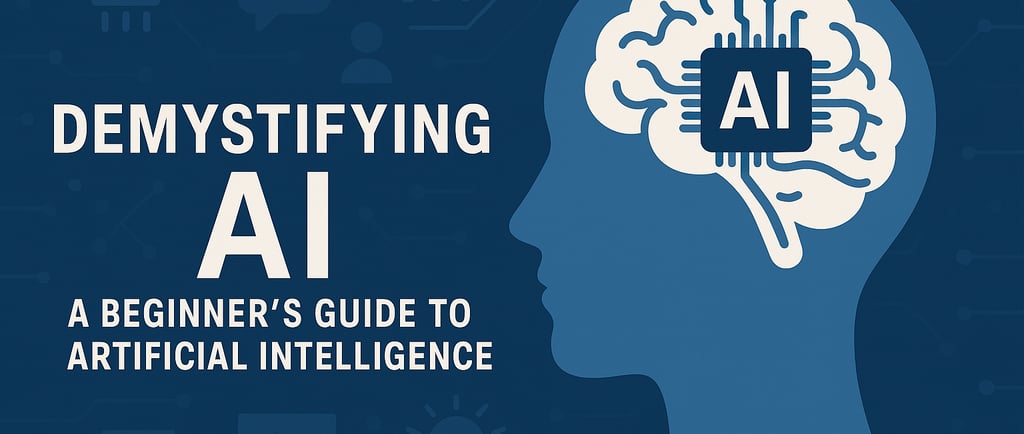
Demystifying AI: The beginners guide.
Don't worry this is not skynet.
Shane Brown
3/31/20253 min read


Demystifying AI: A Beginner's Guide to Artificial Intelligence
Introduction
Artificial Intelligence, or AI, has become one of the most talked-about technologies in recent years. From virtual assistants like Siri and Alexa to recommendations on streaming platforms, AI is already a part of our daily lives. But what exactly is AI, and how does it work? This blog aims to break down the basics of AI in simple terms for those who are just beginning their journey into the tech world.
What is Artificial Intelligence?
At its core, Artificial Intelligence is a field of computer science focused on creating systems that can perform tasks that typically require human intelligence. These tasks include:
Understanding natural language
Recognizing patterns
Learning from experience
Making decisions
Solving problems
Unlike traditional software that follows explicit instructions, AI systems can learn from data and improve over time, often finding solutions that programmers didn't explicitly code.
Types of AI
AI can be categorized in several ways, but for beginners, it's helpful to understand these main types:
Narrow AI (or Weak AI)
This is AI designed to perform specific tasks. Examples include:
Voice assistants (Siri, Alexa)
Recommendation systems (Netflix, Spotify)
Image recognition software
Spam filters in email
This is the type of AI that exists today and is widely used in various applications.
General AI (or Strong AI)
This would be AI with human-like intelligence across a wide range of tasks. While often portrayed in science fiction movies like "Ex Machina" or "Her," true General AI doesn't exist yet and might be decades away from development.
How Does AI Work? A Simple Explanation
AI works through different approaches, but the most common today is Machine Learning. Here's a simplified explanation of how it works:
Data Collection: First, the AI system is provided with large amounts of data.
Training: The system analyzes this data to identify patterns.
Building a Model: Based on these patterns, the system creates a model or set of rules.
Making Predictions: When given new data, the system uses its model to make predictions or decisions.
Feedback: The system receives feedback on whether its predictions were correct.
Improvement: The system adjusts its model based on this feedback to improve future predictions.
Think of it like teaching a child to recognize animals. You show them many pictures of cats and dogs, explaining which is which. Eventually, they learn to identify cats and dogs on their own, even ones they've never seen before.
Real-World Applications of AI
AI isn't just a concept in sci-fi movies—it's already making an impact in many areas:
Personal Technology
Smartphone Features: Face recognition, voice assistants, predictive text
Smart Home Devices: Thermostats that learn your preferences, security cameras that recognize familiar faces
Healthcare
Disease Detection: AI algorithms that can spot patterns in medical images
Personalized Medicine: Treatment plans tailored to individual patient data
Drug Discovery: Accelerating the process of finding new medications
Education
Personalized Learning: Adaptive systems that adjust to student needs
Automated Grading: Freeing up teacher time for more meaningful interaction
Language Learning: AI-powered apps that provide customized practice
Business
Customer Service: Chatbots that handle common questions
Data Analysis: Finding insights in vast amounts of business data
Process Automation: Handling repetitive tasks to boost efficiency
Common Misconceptions About AI
As a beginner, you might have heard some myths about AI. Let's clear these up:
Myth: AI will replace all human jobs. Reality: While AI will change some job roles, it's more likely to augment human work rather than replace it entirely. New jobs will also emerge.
Myth: AI systems are conscious or have emotions like humans. Reality: Current AI systems don't have consciousness or emotions. They recognize patterns in data but don't "understand" in the human sense.
Myth: AI is only for tech experts. Reality: Many AI tools are designed to be user-friendly. You don't need to be a programmer to benefit from AI technology.
Getting Started with AI
Interested in exploring AI further? Here are some beginner-friendly resources:
Online Courses: Platforms like Coursera, edX, and Khan Academy offer introductory AI courses.
No-Code AI Tools: Try out tools like Google's Teachable Machine or RunwayML that let you experiment with AI without coding.
AI News Sources: Websites like AI Trends, MIT Technology Review, and Towards Data Science publish articles about AI developments in accessible language.
Conclusion
Artificial Intelligence may seem complex at first glance, but understanding its basic principles doesn't require advanced technical knowledge. As AI continues to evolve and become more integrated into our daily lives, having a fundamental understanding of this technology will become increasingly valuable.
Remember, everyone starts somewhere, and the journey into understanding AI begins with these fundamental concepts. In future blog posts, we'll dive deeper into specific AI applications and how they're changing the world around us.
Nerd Joke of the day:
What's a programmer's favorite place to hang out?
The Foo Bar.
